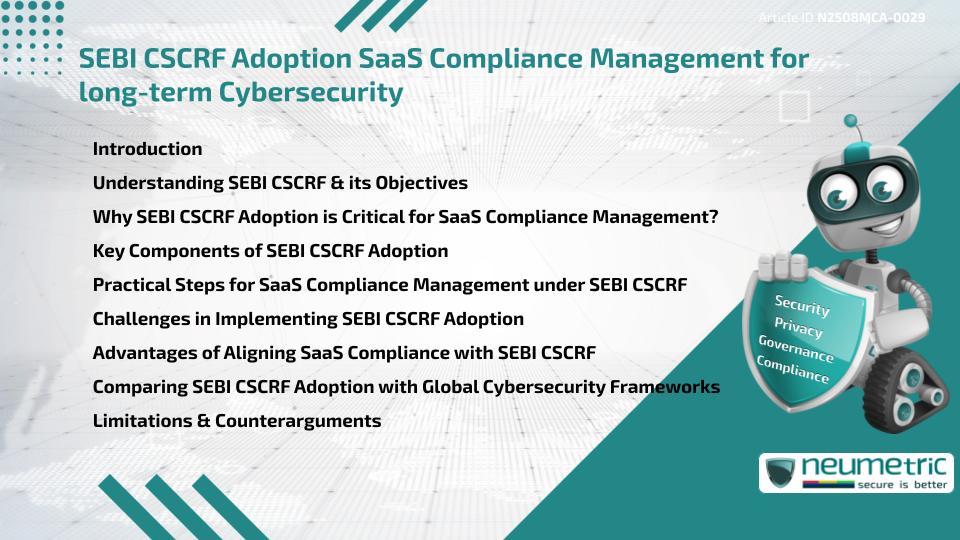Table of Contents
ToggleIntroduction
The Securities & Exchange Board of India [SEBI] introduced the Cybersecurity & Cyber Resilience Framework [CSCRF] to strengthen the resilience of market intermediaries against cyber Risks. SEBI CSCRF adoption SaaS compliance management has emerged as a critical approach for regulated entities to safeguard Sensitive Data, ensure operational continuity & maintain investor trust. By integrating SEBI CSCRF adoption SaaS compliance management into organizational strategies, firms benefit from structured Risk controls, regulatory alignment & long-term Cybersecurity. This article explores the purpose, implementation, advantages & limitations of this Framework, offering insights for Organisations operating in technology-driven Financial ecosystems.
Understanding SEBI CSCRF & its Objectives
SEBI designed the CSCRF to enhance cyber resilience across securities markets. Its core objectives include:
- Establishing Governance structures for Cybersecurity.
- Ensuring Continuous Monitoring of systems & networks.
- Promoting Incident Response readiness.
- Enhancing Data Protection & regulatory reporting mechanisms.
The Framework acts as a benchmark for intermediaries to strengthen operational safeguards while aligning with regulatory obligations.
Why SEBI CSCRF Adoption is Critical for SaaS Compliance Management?
With businesses relying heavily on Software as a Service [SaaS] platforms, compliance Risks expand significantly. SEBI CSCRF adoption SaaS compliance management ensures that Financial Organisations using SaaS Providers maintain accountability & security. Without a structured compliance management process, data breaches & operational disruptions could expose firms to Financial penalties & reputational loss. The Framework provides a roadmap for aligning SaaS practices with Cybersecurity norms & Risk Management protocols.
Key Components of SEBI CSCRF Adoption
SEBI CSCRF adoption requires Organisations to follow key principles:
- Governance & accountability: Defining responsibilities across leadership & technical teams.
- Risk Assessment: Identifying & mitigating Vulnerabilities within SaaS platforms.
- Incident management: Establishing processes for detection, response & recovery.
- Third Party oversight: Monitoring SaaS vendors for compliance & security assurance.
- Continuous Improvement: Updating practices to address evolving Cyber Threats.
These components help firms move from reactive security practices to proactive compliance management.
Practical Steps for SaaS Compliance Management under SEBI CSCRF
Organisations can adopt structured steps to align SaaS compliance with SEBI CSCRF:
- Conduct a Gap Analysis against CSCRF requirements.
- Map SaaS vendor controls with regulatory expectations.
- Implement Continuous Monitoring Tools.
- Develop Incident Response simulations.
- Train Employees on data handling & compliance obligations.
Such measures ensure that compliance is not a one-time exercise but a continuous responsibility.
Challenges in Implementing SEBI CSCRF Adoption
Despite its advantages, Organisations face challenges such as:
- Limited awareness about detailed Framework requirements.
- High costs of integrating monitoring technologies.
- Complexities in managing multiple SaaS vendors.
- Resistance to cultural change within Organisations.
Balancing Regulatory Compliance with operational efficiency requires careful planning & execution.
Advantages of Aligning SaaS Compliance with SEBI CSCRF
SEBI CSCRF adoption SaaS compliance management offers multiple benefits:
- Stronger Data Security across Financial transactions.
- Enhanced trust with investors & Stakeholders.
- Reduced regulatory penalties & Financial losses.
- Streamlined Governance & accountability structures.
This alignment improves both regulatory posture & market competitiveness.
Comparing SEBI CSCRF Adoption with Global Cybersecurity Frameworks
Globally, frameworks like the National Institute of Standards & Technology [NIST] Cybersecurity Framework & International organisation for Standardization [ISO] 27001 share similarities with SEBI CSCRF. All frameworks emphasize Governance, Risk Management & Incident Response. However, SEBI CSCRF is tailored specifically for India’s securities market ecosystem, making it more focused in scope. While international frameworks provide broader applicability, SEBI CSCRF offers targeted compliance standards for domestic Financial entities.
Limitations & Counterarguments
Critics argue that SEBI CSCRF adoption may lead to increased compliance overhead & reduced agility. Smaller firms, in particular, may find the requirements burdensome. Additionally, dependency on SaaS Providers introduces complexities, as Organisations may not have full visibility into vendor operations. However, despite these challenges, the Framework remains a necessary safeguard against rising Cyber Threats.
Takeaways
- SEBI CSCRF adoption SaaS compliance management is a regulatory requirement & a security necessity.
- Firms gain long-term Cybersecurity resilience & investor trust.
- Implementation requires proactive Governance, vendor oversight & Continuous Monitoring.
- Challenges exist but are outweighed by the benefits of compliance.
FAQ
What is SEBI CSCRF adoption SaaS Compliance Management?
It is the integration of SEBI’s Cybersecurity & Cyber Resilience Framework into SaaS compliance strategies to safeguard Financial data & ensure regulatory alignment.
Why is SEBI CSCRF adoption important for Financial Organisations?
It protects against data breaches, ensures Regulatory Compliance & strengthens investor confidence.
How does SEBI CSCRF adoption apply to SaaS Providers?
Organisations must ensure that their SaaS vendors comply with CSCRF standards, particularly in Data Protection, monitoring & incident management.
What challenges do firms face in SEBI CSCRF adoption?
Key challenges include high implementation costs, vendor oversight complexities & limited internal expertise.
Can SEBI CSCRF be compared with ISO 27001?
Yes, while ISO 27001 offers global applicability, SEBI CSCRF focuses on Indian securities markets, making it more industry-specific.
Does SEBI CSCRF adoption require Employee Training?
Yes, Employee awareness & training are critical for compliance, as human error remains a leading cause of cyber incidents.
What are the benefits of aligning SaaS compliance with SEBI CSCRF?
Benefits include stronger Data Security, better Regulatory Compliance, improved trust & reduced Risks of Financial penalties.
Need help for Security, Privacy, Governance & VAPT?
Neumetric provides organisations the necessary help to achieve their Cybersecurity, Compliance, Governance, Privacy, Certifications & Pentesting needs.
Organisations & Businesses, specifically those which provide SaaS & AI Solutions in the Fintech, BFSI & other regulated sectors, usually need a Cybersecurity Partner for meeting & maintaining the ongoing Security & Privacy needs & requirements of their Enterprise Clients & Privacy conscious Customers.
SOC 2, ISO 27001, ISO 42001, NIST, HIPAA, HECVAT, EU GDPR are some of the Frameworks that are served by Fusion – a SaaS, multimodular, multitenant, centralised, automated, Cybersecurity & Compliance Management system.
Neumetric also provides Expert Services for technical security which covers VAPT for Web Applications, APIs, iOS & Android Mobile Apps, Security Testing for AWS & other Cloud Environments & Cloud Infrastructure & other similar scopes.
Reach out to us by Email or filling out the Contact Form…


